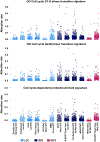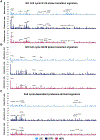Genomic alterations impact cell cycle-related genes during prostate cancer progression
- PMID: 33852421
- PMCID: PMC8496939
- DOI: 10.1530/ERC-21-0091
Genomic alterations impact cell cycle-related genes during prostate cancer progression
Abstract
The recent genomic characterization of patient specimens has started to reveal the landscape of somatic alterations in clinical prostate cancer (CaP) and its association with disease progression and treatment resistance. The extent to which such alterations impact hallmarks of cancer is still unclear. Here, we interrogate genomic data from thousands of clinical CaP specimens that reflect progression from treatment-naïve, to castration-recurrent, and in some cases, neuroendocrine CaP for alterations in cell cycle-associated and -regulated genes, which are central to cancer initiation and progression. We evaluate gene signatures previously curated to evaluate G1-S and G2-M phase transitions or to represent the cell cycle-dependent proteome. The resulting CaP (stage)-specific overview confirmed the presence of well-known driver alterations impacting, for instance, the genes encoding p53 and MYC, and uncovered novel previously unrecognized mutations that affect others such as the PKMYT1 and MTBP genes. The cancer dependency and drugability of representative genomically altered cell cycle determinants were verified also. Taken together, these analyses on hundreds of often less-characterized cell cycle regulators expand considerably the scope of genomic alterations associated with CaP cell proliferation and cell cycle and isolate such regulatory proteins as putative drivers of CaP treatment resistance and entirely novel therapeutic targets for CaP therapy.
Keywords: cell proliferation; driver mutation; precision medicine; treatment resistance.
Conflict of interest statement
Figures


Similar articles
-
Novel insights in cell cycle dysregulation during prostate cancer progression.Endocr Relat Cancer. 2021 May 11;28(6):R141-R155. doi: 10.1530/ERC-20-0517. Endocr Relat Cancer. 2021. PMID: 33830069 Free PMC article. Review.
-
Intratumoral and Intertumoral Genomic Heterogeneity of Multifocal Localized Prostate Cancer Impacts Molecular Classifications and Genomic Prognosticators.Eur Urol. 2017 Feb;71(2):183-192. doi: 10.1016/j.eururo.2016.07.008. Epub 2016 Jul 21. Eur Urol. 2017. PMID: 27451135 Free PMC article.
-
Targeted next-generation sequencing of advanced prostate cancer identifies potential therapeutic targets and disease heterogeneity.Eur Urol. 2013 May;63(5):920-6. doi: 10.1016/j.eururo.2012.08.053. Epub 2012 Sep 5. Eur Urol. 2013. PMID: 22981675 Free PMC article.
-
Genomic, pathological, and clinical heterogeneity as drivers of personalized medicine in prostate cancer.Urol Oncol. 2015 Feb;33(2):85-94. doi: 10.1016/j.urolonc.2013.10.020. Epub 2014 Apr 24. Urol Oncol. 2015. PMID: 24768356 Review.
-
PKMYT1 is associated with prostate cancer malignancy and may serve as a therapeutic target.Gene. 2020 Jun 20;744:144608. doi: 10.1016/j.gene.2020.144608. Epub 2020 Mar 29. Gene. 2020. PMID: 32234541
Cited by
-
Characterization of tumor microenvironment infiltration and therapeutic responses of cell cycle-related genes' signature in breast cancer.J Cancer Res Clin Oncol. 2023 Nov;149(15):13889-13904. doi: 10.1007/s00432-023-05198-9. Epub 2023 Aug 4. J Cancer Res Clin Oncol. 2023. PMID: 37540256 Free PMC article.
-
The role of GATA4 in mesenchymal stem cell senescence: A new frontier in regenerative medicine.Regen Ther. 2024 Dec 25;28:214-226. doi: 10.1016/j.reth.2024.11.017. eCollection 2025 Mar. Regen Ther. 2024. PMID: 39811069 Free PMC article. Review.
References
-
- KASTEN M & GIORDANO A 2001. Cdk10, a Cdc2-related kinase, associates with the Ets2 transcription factor and modulates its transactivation activity. Oncogene, 20, 1832–8. - PubMed
Publication types
MeSH terms
Substances
Grants and funding
LinkOut - more resources
Full Text Sources
Other Literature Sources
Medical
Research Materials
Miscellaneous

